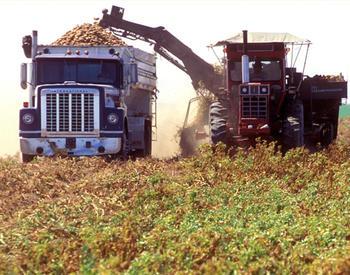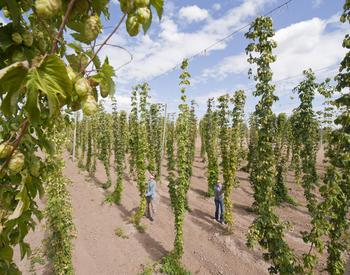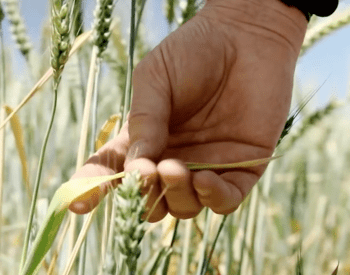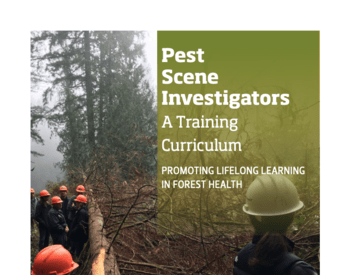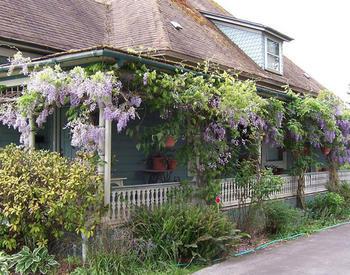hello and welcome to section one of the
mapping and measurements module part of
the how-to manager forest
online series my name is Tristan huff
and I'm an extension Forester with
Oregon State University I'll be your
instructor for this module the how-to
manager forest online series is all
about helping you achieve your goals and
objectives for your property now a good
inventory can help you meet your goals
by answering some important questions
these questions include what do you have
in your forest where are those resources
located how are those resources doing
and you need to make any changes in
order to help you meet your goals so
what do I mean when I say a forest
inventory basically an inventory is
simply an account of what you have out
your woods this could include things
like the vegetation whether that's
mature timber or young growing trees or
even understory vegetation it would also
include wildlife water features like
streams and ponds you might also want to
include in your inventory the
infrastructure that helps you manage
your woods this would be things like
roads trails culverts etc an inventory
might include special sites which are
simply areas on your property that have
special significance either to your
family or in a general historic sense
things like Pioneer cemeteries old
homesteads etc beyond these resources
you might also want to inventory some
more negative aspects things like
invasive species or insect and disease
outbreaks now all these things could be
included in an inventory but you'll want
to pick and choose the ones that are
important to you so that your inventory
is working for you the goal of this
module is to give you the tools and
resources you need to 6
inventory woods we'll start by talking
about the land survey system then we'll
get into a discussion of the various
maps and aerial photos that are
available to help you in your management
of your woods in part 2 of this module
we'll walk you through the step-by-step
process of actually creating a forest
inventory finally we'll talk about some
of the vocabulary and methods used to
measure forest products that come off
your property the public land survey
system is the method by which the United
States were initially divided to
facilitate turning public lands over to
private ownership when our country was
initially surveyed early in its history
the public land survey system was used
to divide ground up into smaller and
smaller squares this system of grids
within grids is still used today to
delineate individual tax Lots and to
determine private ownership to find out
where your property fits within the
public land survey system just look do
your deed here you'll find what's known
as the legal description an example one
we have here reads the southwest quarter
of the south east quarter of section
twenty one Township twenty-one South
Range eleven west lam meridian douglas
county oregon will decipher exactly what
this means in the next few slides first
let's start with that Willamette
Meridian part meridians break the
country up into large grids which form
the basis for the public land survey
system if your property is within Oregon
then you are in the Willamette Meridian
all meridians have what's known as an
initial point which is the starting spot
where all surveys for that Meridian
originated the initial point for the
Willamette meridian is a place called
the lam stone just like its name implies
it's a big rock that sits in a part
southwest of Portland you can go and
visit it if you want
as I mentioned earlier the public land
survey system is basically a system of
grids within grids we just talked about
meridians which are the largest grids in
the system
now meridians are broken down further
into smaller grids known as townships
townships are six miles square and
they're labeled based on their location
relative to the initial point of the
meridian townships are called by their
position north and south we call this
their township and we label them based
on their direction east or west from the
initial point we call this the range
this might not make sense but let me
explain it further here with an example
this township is two down and four east
of the initial point in the grid of
townships so we would label this one
Township two South Range four East this
Township is southwest of the initial
point we would call this Township
Township four South Range five west
okay let's zoom in even further
townships are broken up into 36 equally
sized sections now since a township is
six miles by six miles each section is
going to be one mile square and that one
mile square section contains 640 acres
sections are numbered based on where
they are in the township and that
numbering always starts in the northeast
corner of this Township with one and
then zigzags down the township until you
reach the southeast corner and section
36 this might seem like a strange way to
number the sections but remember those
surveyors back in the day were walking
through the woods as they surveyed the
ground and this is the route that they
took as they surveyed each Township
these one-mile square sections are
further divided into quarters with a
hundred and sixty acres each half
quarters with eighty acres each and
quarter orders with forty acres each
this breakdown into quarter quarters
half quarters and full quarters is why
most tax Lots nowadays contain multiples
of forty acres so we've seen the
breakdown for meridians two townships
two sections and finally two tax Lots
with in sections so this breakdown of
grids within grids is the public land
survey system in a nutshell now I've
been using the term acre a lot to talk
about area and I want to articulate
exactly what an acre is we all probably
have a pretty good sense of what an acre
of ground looks like but in numbers an
acre equals 43,560 square feet this
equates to a square with about 208 feet
on each side we can also think of acres
in terms of chains now a chain is a
commonly used unit of length used in
surveying and forestry and each chain
contains 66 feet an acre contains 10
square chains good maps are an important
part of any forest inventory they define
two property boundaries and help locate
resources within your woods maps can
also help you quantify features in your
woods for example they can help you
determine how many miles of roads you
have or how many acres of mature timber
you own there are many different types
of maps you can use in your forest
inventory but we're going to talk about
the most commonly used ones plat maps
topographic maps aerial photos and soil
Maps first let's talk about plat maps
plot maps are the official maps used to
graphically display tax Lots
they usually contain one section per
remember sections are one mile square
sometimes when there are many small tax
Lots in a small area such as in a
residential development sections can be
divided up into multiple plot maps so
they're easier to read now there are
lots of different features contained in
a plat map these include roads physical
features like rivers and lakes plot maps
also contain public land survey
information basically they tell you what
township and section you're in and plat
maps also contained ownership boundaries
so basically each tax lot will be drawn
out on the plat map this lets you know
where your property boundaries sit in
relation to your neighbors
now these maps can be found either at
your local assessor's office or online
topographic maps are useful because they
contain information on the terrain
contour lines follow the slope and show
areas of equal elevation the interval is
the elevation difference between these
lines when the contour lines are close
together that indicates a steep slope
whereas widely spaced contour intervals
show areas that are not as steep streams
are going to show up as v's the point up
hill whereas ridges are going to show up
is use the point down hill aerial photos
are very useful when managing your woods
you can use them to determine what types
of vegetation cover you have you can
locate roads and landings don't show up
on any map and you can also locate areas
of concern like under stocked areas or
disease outbreaks aerial photos are
available from lots of different sources
you might look to local land management
agencies such as the Oregon Department
of Forestry Bureau of Land Management or
the u.s. Forest Service because
sometimes
land might border yours and they might
have aerial photos that cover your land
the Natural Resource Conservation
Service or the Farm Service Agency often
has aerial photos available to private
landowners to use in their land
management or you might also talk to
your Oregon State University Extension
agent you can also look online there are
lots of good sources there for quality
aerial photos including places like
Google Earth Bing Maps or any of the
other online mapping sources they often
have fairly high quality and recent
aerial photos available soil survey maps
are a specialized type of map that
contained information on the different
soil types found within your County you
can use these maps to figure out what
soil type is found on your specific
property once you know what soil type
you have you can use this information to
help guide your forest management these
soil survey maps are available through
your Natural Resource Conservation
Service office or from your Oregon State
University Extension office soil survey
maps can be found in the old soil survey
books like the one on the left or you
can go online to web soil survey to find
the same information using web soil
survey you can create custom maps that
show the different soil types on your
property as well as different
characteristics of that soil relative to
forest management a management map is
probably the most useful map to you
because it's one that you make these
maps can be either hand drawn or
computer-generated but the key thing is
is that they contain features that are
important to you based on your
management needs you might include
things like timber stands roads water
features like streams and ponds or even
fence lines the key thing is if you
include things on your map they're going
to make it more useful to you and your
management as I just mentioned
management Maps can be either hand-drawn
or created using the help of a computer
there are lots of computer programs
available that can help you make a very
high quality management map most of
these programs are what we would call a
GIS or geographic information system
these programs take geographic
information and allow you to make
complex analyses and to create maps
while some GIS programs are fairly
expensive and difficult to learn there
are some free user-friendly options
available online GPS units are handheld
devices that use satellites to pinpoint
your location on earth these can be
useful when combined with computer
mapping because they help you accurately
locate features on the ground remember
though that since these devices use
satellites to track your location
accuracy can be quite poor under a
forest canopy while a GPS can be a very
handy way to navigate around your woods
compasses are still a great low-tech
solution we won't go into the details of
using a compass but I wanted to discuss
magnetic declination which has a big
influence on how your compass works
basically the issue is that there are
local differences between true north
that's the direction to the North Pole
and the way most maps are oriented and
magnetic north which is where your
compass points the problem is is Earth's
magnetic field doesn't arrange itself in
a perfect north-south direction so there
are important local differences in the
direction your compass points this
difference between true north and
magnetic north is known as magnetic
declination in Oregon declination is
always going to be to the east and it's
going to range between 14 degrees in the
extreme southeast of Oregon and 17
degrees in Northwest Oregon that's a
pretty big difference and it'll lead to
inaccuracies
if you don't calibrate your compass
before using it to figure out exactly
what the declination is in your area you
can either
at USGS topographic maps or go online
where they list the exact magnetic
declination for your area okay
let's look back on what we've learned so
far we've learned that an inventory is
an essential part of any forest
management plan we talked about the
public land survey system and how it
locates your property in the whole
scheme of things we also learned about
different types of maps that can help
you in the management of your woods in
part 2 of this module we'll be learning
how to create a forest inventory we'll
go through the process step by step
learning about creating a management map
designing your inventory and measuring
trees also in part 2 we'll talk about
measuring the forest products that come
off of your property thanks for
listening I hope you'll join us for part
two of this module











